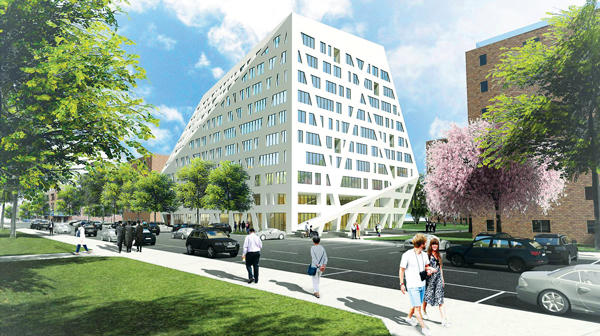Trending
Libeskind’s lackluster debut
The architect’s first NYC building shows little of the brilliance he’s brought to previous work

In New York, Daniel Libeskind is undoubtedly best known for his work as the master planner of the World Trade Center redevelopment. But he still does not have a building to his name in the city, which he has called home for nearly 60 years — though he came close with One World Trade, before famously being replaced by Skidmore Owings & Merrill.
Now, however, Libeskind’s status in NYC is about to change.
The 71-year-old Polish-American starchitect has teamed up with the city in a design that appears to be a significant departure for his shop.
Studio Libeskind, which has locations in New York and Switzerland, just released renderings for a residential development in Brooklyn’s Bedford-Stuyvesant that will provide affordable housing for senior citizens.
The 10-story building, which will sit on the 22-acre campus of the Sumner Houses, is part of Mayor Bill de Blasio’s push to preserve or construct 300,000 units of affordable housing by 2026.
The project is expected to break ground in 2020, and when it’s completed, it will contain 197 apartments and 20,000 square feet of community space.
The building is being developed on city-owned land by a group of nonprofit organizations in exchange for a 99-year ground lease.
While providing affordable homes for low-income seniors — the project is designed for those with incomes of up to about $40,000 a year — is surely a worthy cause, the success of the project’s design is more questionable.

Architect Daniel Libeskind
In my view, there are two main flaws in Libeskind’s plan. The first is related to the building’s aesthetics, the second to its function.
Let it be said that there are many architects today who favor the deconstructivist style that Libeskind pioneered, but precious few of them can bring any sense of freshness to it. Daniel Libeskind is one of the few who can pull it off.
In this respect, he is — at his best — a far more interesting architect in purely formal terms than, say, Frank Gehry, Rem Koolhaas, Bjarke Ingels and the late Zaha Hadid.
Some of Libeskind’s designs are definitively brilliant — and they don’t display the clamorous self-consciousness that mars the works of Gehry, Hadid and Koolhaas.
In the Dresden Museum of Military History, for example, Libeskind’s sharply angled glass annex has been attached to a pre-existing neoclassical structure in a way that enlivens both the old and the new structures. A similar jaggedness informs the Denver Art Museum, a shark of a building that’s clad in metal.
Also memorable is the architect’s Vanke Pavilion, which was on display during Expo 2015, an international fair that was mounted in Milan for six months. The pavilion resembled a giant snakeskin, with a scaly bright red exterior.
At the Sumner Houses, unfortunately, Libeskind’s brilliance is nowhere in sight — or at least it is not visible in the renderings.
This is not the first time that New York City has seemingly dragged down the design of a prominent architect, moving it toward a state of mediocrity. We have seen similar results with Herzog & de Meuron, Arquitectonica and Renzo Piano, to name only a few.
Covered in a pale white cladding, the Brooklyn building resembles an irregularly shaped box — or a cut quartz crystal.
The facade is crisscrossed with flat diagonals, which don’t seem to serve a structural function.
The building buckles and protrudes in ways that make no visual, functional or experiential sense — at least to me.
The design looks like the kind of hand-me-down radicalism that tends to creep onto the New York City skyline, often about a generation after the style has ceased to have any radical credibility.
The very busyness of the facade appears to block some of the light passing through the windows at some points on the structure.
Although the design seems dull to this viewer, I suspect that Libeskind would argue that there is something inherently revitalizing about bringing this out-of-the-box building to an area currently marked by staid square housing projects. But it seems unlikely that this building will play well with the other buildings in the Sumner Houses complex.
The revitalization argument would be more persuasive if the design were better. And while the city has touted the fact that it solicited input from the community — holding 15 public meetings for neighborhood residents — it seems likely that since even the rendering looks a little tired, that the finished product will appear only more so.




